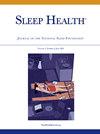Sustained impacts of neighborhood investments on sleep health over a 5-year period: Insights from a natural experiment in two urban neighborhoods in the United States
IF 3.4
2区 医学
Q2 CLINICAL NEUROLOGY
引用次数: 0
Abstract
Study objectives
Neighborhood disinvestment is a downstream impact of structural racism, especially afflicting minoritized communities. Thus, neighborhood reinvestment may serve as a policy-level intervention to mitigate sleep and other health disparities. This study builds on previous work by leveraging a natural experimental design to evaluate the 5-year effects of neighborhood investments on residents' sleep.
Methods
Data are from the PHRESH Zzz study, a natural experiment conducted in two low-income, predominantly Black American, urban neighborhoods in Pittsburgh, Pennsylvania, with a randomly selected cohort [n = 567; mean age = 54.8 (SD = 14.8); 77.6% female; 96% Black]. Sleep duration, wakefulness after sleep onset, and sleep efficiency were assessed via actigraphy and sleep quality via survey in 2013, 2016, and 2018. All publicly funded neighborhood investments between 2013 and 2016 were recorded and geocoded to calculate the distance from each respondent’s residence to the investment. The primary exposure variable was residents’ proximity to neighborhood investments (<0.1 of a mile).
Results
The overall pattern of results showed worsening sleep over time, regardless of exposure to investments. However, over the 5-year period, those who lived physically close to investments (<0.1 mile) experienced significantly smaller decreases in sleep efficiency and smaller increases in wakefulness after sleep onset, relative to those who lived farther away.
Conclusions
Previously, we found that living near a neighborhood investment improved sleep outcomes over a short-term period of 3 years. Current results indicate that improvements were partially sustained over 5 years. Findings have implications for policy initiatives targeting upstream, structural determinants of sleep health disparities.
社区投资对5年睡眠健康的持续影响:来自美国两个城市社区的自然实验的见解。
研究目的:社区撤资是结构性种族主义的下游影响,尤其是对少数族裔社区的影响。因此,邻里再投资可以作为政策层面的干预措施来缓解睡眠和其他健康差异。本研究建立在以前的工作基础上,利用自然实验设计来评估社区投资对居民睡眠的5年影响。方法:数据来自PHRESH Zzz研究,这是一项自然实验,在宾夕法尼亚州匹兹堡的两个低收入,主要是黑人的城市社区进行,随机选择队列[n=567;平均年龄54.8岁(SD=14.8);77.6%的女性;96%是黑人。研究人员分别于2013年、2016年和2018年通过活动记录仪评估睡眠持续时间、睡眠后清醒情况和睡眠效率,并通过调查评估睡眠质量。记录2013年至2016年期间所有公共资助的社区投资并进行地理编码,以计算从每个受访者的住所到投资的距离。主要的暴露变量是居民与社区投资的接近程度(结果:总体结果模式显示,随着时间的推移,无论投资的暴露程度如何,睡眠都会恶化。然而,在5年的时间里,那些住得离投资场所近的人(结论:之前,我们发现住得离投资场所近的人在3年的短期内改善了睡眠结果。目前的结果表明,改善部分持续了5年。研究结果对针对睡眠健康差异的上游结构性决定因素的政策举措具有启示意义。
本文章由计算机程序翻译,如有差异,请以英文原文为准。
求助全文
约1分钟内获得全文
求助全文
来源期刊

Sleep Health
CLINICAL NEUROLOGY-
CiteScore
6.30
自引率
9.80%
发文量
114
审稿时长
54 days
期刊介绍:
Sleep Health Journal of the National Sleep Foundation is a multidisciplinary journal that explores sleep''s role in population health and elucidates the social science perspective on sleep and health. Aligned with the National Sleep Foundation''s global authoritative, evidence-based voice for sleep health, the journal serves as the foremost publication for manuscripts that advance the sleep health of all members of society.The scope of the journal extends across diverse sleep-related fields, including anthropology, education, health services research, human development, international health, law, mental health, nursing, nutrition, psychology, public health, public policy, fatigue management, transportation, social work, and sociology. The journal welcomes original research articles, review articles, brief reports, special articles, letters to the editor, editorials, and commentaries.
 求助内容:
求助内容: 应助结果提醒方式:
应助结果提醒方式:


